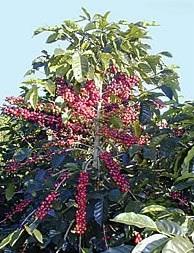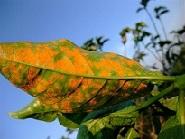 |
Interesting Articles about Popular Topics |
|
|
Dave Carlson - March 20, 2013 The next time you pick up your favorite coffee cup and wonder why the cost of coffee continues to rise, blame it on fungus. The roya fungus, also known as leaf rust, is killing arabica coffee shrub leaves in Central and South America by sapping nutrients and reducing bean yields. The fungus weakens trees by causing leaves to turn black and fall off. 
In their weakened state, coffee plants are susceptible to other diseases and parasites. In cases of severe infestation, leaf rust can contribute to the plant's death. Once the fungus fully establishes itself in coffee leaves, it may be too late for treatment. The best protection method is early discovery and pro-active prevention. 
Leaf rust is reaching epidemic proportions in many locations in the Central American countries of Costa Rica, El Salvador, Guatemala, Honduras, Mexico, and Nicaragua. Instituto del Café de Costa Rica (ICAFE) weighed in on the issue. Jorge Ramirez, technical manager of ICAFE, and Ronald Peters, ICAFE President, both predicted dire consequences if the fungus spread is not brought under control. Arabica coffee production is expected to be drastically down in Costa Rica this year. Roya fungus infestations are expected to decimate about 12% of the country’s coffee trees before the 2013/2014 season ends. Ramirez predicted that the pandemic will destroy more than 11,000 hectares of Costa Rica’s planted coffee plants during the 2013/2014 season. (Total coffee production area covers about 93,000 hectares.) In January 2013, the Costa Rican government declared a national emergency to wrestle with the spreading roya fungus. The emergency program will provide about $4 million toward cost of fungicides and research to defeat the leaf rust outbreak. Hopefully, this effort will be enough to reduce the economic catastrophe for Costa Rica’s coffee industry. Agriculture leaders in Nicaragua have coordinated to form a coalition of more than 15,000 agronomists, trained farmers, and volunteers to educate coffee farmers about roya fungus treatment methods. They also will distribute materials the farmers can use to fight the fungus onslaught. Since funds are limited, the coalition will rely on volunteerism and donations to carry out their mission. The retail coffee giant Starbucks has jumped in to help protect their coffee supplies. In early 2013, Starbucks went into the coffee production business. They purchased their first coffee farm, covering about 600 acres in Costa Rica. They plan to grow and harvest their own beans, while researching issues related to coffee production. Starbucks will convert their new acquisition into a global agronomy research and development center. Early discovery and effective application of costly pesticides can provide protection from roya attacks, but an effective long-term solution should be the goal for coffee farmers. One effective solution in Columbia is to eventually replace coffee plants with more resistant strains. This is not a short term solution, since the coffee farm probably will show a dip in production until the newly planted trees mature. Protection of coffee crops is a long-term investment for the future. 
Will future coffee shops add loan officers to their staff to provide you with a cash infusion to purchase a cup of coffee? Will coffee pass oil and the world’s most expensive commodity? If leaf rust is not brought under control the world’s coffee supplies may be threatened. Control of roya fungus can maintain a positive path toward keeping your coffee cup full of an affordable beverage. |
||||
|